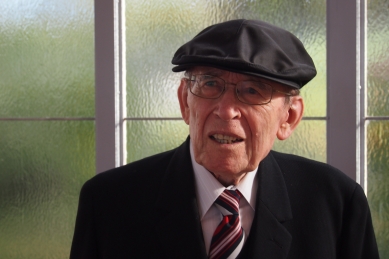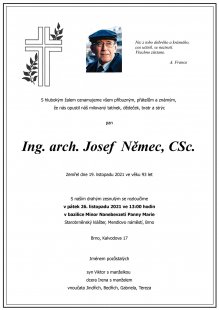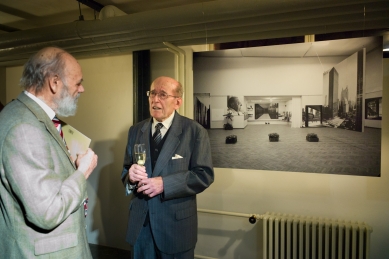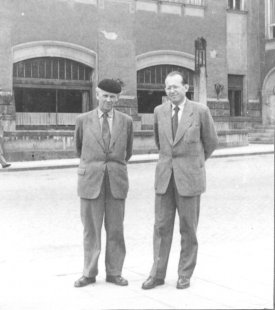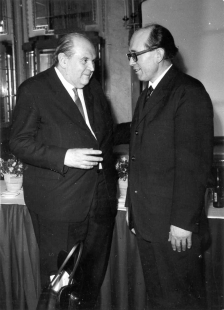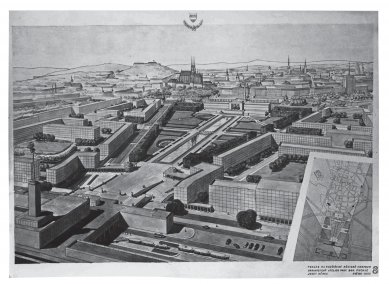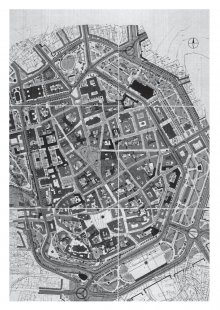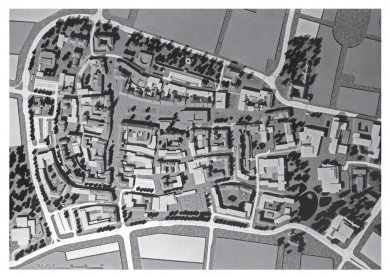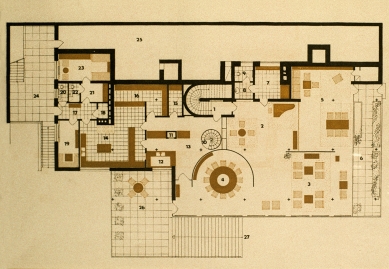
The Brno architect and urban planner Josef Němec has died
On Friday, November 19, 2021, a significant Brno architect and urban planner, Josef Němec, emeritus director of the State Institute for the Reconstruction of Historic Cities and Objects (SÚRPMO) Brno, passed away at the age of 93 in Brno.
Josef Němec was born on February 24, 1928, in Dolní Němčí in the Moravian Slovácko region. He enjoyed drawing from childhood, tried landscape painting, and engaged in woodcarving in his father's workshop. He began his studies at the School of Art in Zlin. In 1949, he left Zlin and the already nationalized Baťa company and moved to Brno, where he started studying and permanently settled down. In 1953, he graduated from the Faculty of Architecture and Civil Engineering in Brno, at a time when it represented both the educational and creative elite of Czech architecture, embodied primarily by professors Bohuslav Fuchs, Bedřich Rozehnal, Miloslav Kopřiva, and Vincenc Makovský. His previous training and Baťa practice in the Zlin modern environment aligned with the faculty's profile. He soon became a student and long-time collaborator of Professor Bohuslav Fuchs. However, he had to complete his external aspirancy, which he began in Brno, in 1964 in Bratislava, as he, along with his supervisor Bohuslav Fuchs and other educators, was expelled from the faculty after it was taken over by the "cadre médunovský" leadership in 1958. Nevertheless, he took from the Brno faculty its ideas and a significant motivating impulse for his profession and mission as an architect. He also maintained lifelong friendships from his studies with Kamil Fuchs (the son of Bohuslav Fuchs), Jiří Mikšík, Tomáš Černoušek, and Antonín Škamrada. Until 1968, he undertook several study trips to Italy, Austria, Poland, and the German cities of Weimar and Dessau, the cradle of the Bauhaus. He began his architectural practice in Nitra, Slovakia, with territorial plans for the cities of Nováky and Prievidza, and later in Brno at the Regional Center for Urban Planning, where he worked with architect Jindřich Kumpošt on the spatial plan for the Těrlická Reservoir.
In 1954, Josef Němec actively engaged in the establishment of the newly formed State Institute for the Reconstruction of Historic Cities and Objects (SÚRPMO). It was a new, independent, and professionally specialized design organization in the field of architecture focused on the restoration and reconstruction of architectural monuments, which had previously been limitedly handled only by the R-atelier in Prague's Stavoprojekt. Its members smoothly transitioned into SÚRPMO and established creative cabinets led by prominent personalities of our architectural scene (Bohuslav Fuchs, Jaroslav Fragner, Josef Havlíček). The founding leader was Vilém Lorenc, who, with his successors, successfully created significantly unusual conditions and connections outside the framework of the then socialist building priorities, from which a specific design organization emerged with its own methodological-research base directly connected to the design institute. The institute's external cooperation with generally respected figures in the field of heritage care, such as Zdeněk Wirth, Oldřich Stefan, Emanuel Hruška, Josef Štulc, Aleš Vošahlík, Jiří Grabmüller, and others, was extremely important.
Probably the most famous output of SÚRPMO was the architectural-historical survey (SHP), the methodology of which was refined by Dobroslav Líbal, who belonged to the founding cadre of the institute. The fundamental principles in processing SHP are still valid today and form the backbone of contemporary methodological work in this area. Although the existence of SÚRPMO is mainly associated with the era of socialism, the institute managed to maintain its nationwide scope and earn deserved respect both domestically and abroad. A significant attribute of SÚRPMO was the fair and respectful treatment of cadre-unverified members and the foresight to accept into the institute those whom the normalization process had excluded elsewhere.
With "Baťa enthusiasm," Josef Němec co-founded and built the Moravian studios of SÚRPMO in Brno, Olomouc, and Nový Jičín, becoming their chief architect and later director. Despite many vicissitudes of the time, including various centralization and liquidation efforts, he managed to permanently defend, professionally support, and develop this specialized national institution for Brno and Moravia. Hundreds of projects and realizations for the preservation and restoration of the construction heritage fund were created throughout Moravia, as well as in Bohemia and Slovakia. Many prominent architects, art historians, and heritage preservationists passed through the Brno SÚRPMO under the leadership of Josef Němec.
Josef Němec's professional interest was especially in urbanism. In 1957, he developed the first sanitation spatial plan for the historical center of Brno, which was awarded at the 5th World Congress of the Union of Architects in Moscow in 1958. Following this plan, several infill developments were realized, and Česká Street became the first urban pedestrian zone in former Czechoslovakia. A significant initiative by Josef Němec was the principle of whole-block renovations, which were implemented in Brno in the case of the block of the Old Town Hall and Špalíček in Zelný trh, the Moravian Museum complex, and some monastery complexes, which led to the cleanup of Brno's historical underground.
Among the significant out-of-Brno realizations of Josef Němec is the restoration of the Great Square in Kroměříž (1961–1980) and the local Flower Garden (with Dušan Riedl, 1963–1983). Additionally, it includes the redevelopment of the Upper Square and the former Jewish quarter in Uherský Brod (1970–1978) and urbanism projects for Jihlava, Olomouc, Uherské Hradiště, Holešov, Prostějov, Třebíč, and others.
The only new building by Josef Němec is his own family house with a residential garden in Brno's Masaryk District, constructed between 1963 and 1968 in the concept of Bauhaus-influenced functionalism. In recent years, this exceptional building has drawn the attention of many domestic and foreign researchers and has been repeatedly published, whether in the well-known series about famous villas or in prestigious foreign publications dedicated to European post-war modernism.
Since the early 1970s, Josef Němec was one of the first actively creative architects to initiate the restoration of modern architectural monuments, despite the resistance of some conservative circles within SÚRPMO. It was in Brno's SÚRPMO that he advocated for their design preparations, whether it was the so-called government villa – the Stiassni Villa by Ernst Wiesner in Brno-Pisárky or the Morava sanatorium by Bohuslav Fuchs in Tatranská Lomnica.
It is not widely known that it was Josef Němec who played a key role in the fate of the world-famous Tugendhat Villa in Brno at the turn of the 1970s and 1980s. The city gradually, thanks to his diligent advocacy, became willing to invest resources into its restoration, transforming the original intention for the most urgent repairs into a comprehensive restoration and rescue of the building. During a recent memorial restoration of the Tugendhat Villa, participating architects, art historians, and restorers noted that the original restoration project, created in the early 1980s under the direction of Kamil Fuchs, was of very high quality for that time, and that Brno's SÚRPMO, despite subsequent limiting circumstances during the realization work, played an essential role in saving this icon of world architectural modernism for future generations. It should be noted that the main collaborators of Kamil Fuchs on the Tugendhat Villa restoration project at that time were Jarmila Kutějová, Josef Janeček, and Adéla Jeřábková, along with dozens of other specialists, whose work Josef Němec steadfastly defended and supported. Kamil Fuchs and his design team received a special award and silver medal at the World Architecture Biennale in Sofia in 1987 for the Tugendhat Villa restoration project. In 2015, the Museum of the City of Brno published a separate publication on the thirtieth anniversary of the completion of the first restoration of the villa, prepared by the Study and Documentation Center at the Tugendhat Villa. Josef Němec and his former collaborators contributed their texts to it. The book was very positively received and praised by domestic and foreign experts.
In the 1950s and 1960s, Josef Němec participated in numerous architectural competitions as part of Bohuslav Fuchs' authorship collective. These included the urban situating of the House of Culture in Ostrava (1954) and the new theater in Brno (1956), the design of the town hall and square in Toronto (1957), and the conceptual design for the center of the capital city of Prague (1960, 1st prize). Among his independently authored participations was the competition for the concept of the regeneration of the historic center of Olomouc (1968, 1st prize) and the artistic concept for the decoration of Kroměříž (with Jiří Marek and Jiří Auermüller, 1969, main prize). The work of Josef Němec was presented at jubilee exhibitions of SÚRPMO in Prague and Brno from 1964 to 1984, as well as in Rome, Bologna, and Helsinki from 1987 to 1988.
Josef Němec was a member of the Architects' Association and the BLOK association of architects and artists, a member of the Association for Urbanism and Spatial Planning, and a member of the Moravian-Silesian Academy of Science and Arts. Throughout his creative career, he received numerous awards and honors. Brno recognized his work twice with the City of Brno Award in the field of architecture and urbanism, in 1965 and 2002. In 2019, he received the Vladimír Karfík Award for lifetime achievement.
Josef Němec was born on February 24, 1928, in Dolní Němčí in the Moravian Slovácko region. He enjoyed drawing from childhood, tried landscape painting, and engaged in woodcarving in his father's workshop. He began his studies at the School of Art in Zlin. In 1949, he left Zlin and the already nationalized Baťa company and moved to Brno, where he started studying and permanently settled down. In 1953, he graduated from the Faculty of Architecture and Civil Engineering in Brno, at a time when it represented both the educational and creative elite of Czech architecture, embodied primarily by professors Bohuslav Fuchs, Bedřich Rozehnal, Miloslav Kopřiva, and Vincenc Makovský. His previous training and Baťa practice in the Zlin modern environment aligned with the faculty's profile. He soon became a student and long-time collaborator of Professor Bohuslav Fuchs. However, he had to complete his external aspirancy, which he began in Brno, in 1964 in Bratislava, as he, along with his supervisor Bohuslav Fuchs and other educators, was expelled from the faculty after it was taken over by the "cadre médunovský" leadership in 1958. Nevertheless, he took from the Brno faculty its ideas and a significant motivating impulse for his profession and mission as an architect. He also maintained lifelong friendships from his studies with Kamil Fuchs (the son of Bohuslav Fuchs), Jiří Mikšík, Tomáš Černoušek, and Antonín Škamrada. Until 1968, he undertook several study trips to Italy, Austria, Poland, and the German cities of Weimar and Dessau, the cradle of the Bauhaus. He began his architectural practice in Nitra, Slovakia, with territorial plans for the cities of Nováky and Prievidza, and later in Brno at the Regional Center for Urban Planning, where he worked with architect Jindřich Kumpošt on the spatial plan for the Těrlická Reservoir.
In 1954, Josef Němec actively engaged in the establishment of the newly formed State Institute for the Reconstruction of Historic Cities and Objects (SÚRPMO). It was a new, independent, and professionally specialized design organization in the field of architecture focused on the restoration and reconstruction of architectural monuments, which had previously been limitedly handled only by the R-atelier in Prague's Stavoprojekt. Its members smoothly transitioned into SÚRPMO and established creative cabinets led by prominent personalities of our architectural scene (Bohuslav Fuchs, Jaroslav Fragner, Josef Havlíček). The founding leader was Vilém Lorenc, who, with his successors, successfully created significantly unusual conditions and connections outside the framework of the then socialist building priorities, from which a specific design organization emerged with its own methodological-research base directly connected to the design institute. The institute's external cooperation with generally respected figures in the field of heritage care, such as Zdeněk Wirth, Oldřich Stefan, Emanuel Hruška, Josef Štulc, Aleš Vošahlík, Jiří Grabmüller, and others, was extremely important.
Probably the most famous output of SÚRPMO was the architectural-historical survey (SHP), the methodology of which was refined by Dobroslav Líbal, who belonged to the founding cadre of the institute. The fundamental principles in processing SHP are still valid today and form the backbone of contemporary methodological work in this area. Although the existence of SÚRPMO is mainly associated with the era of socialism, the institute managed to maintain its nationwide scope and earn deserved respect both domestically and abroad. A significant attribute of SÚRPMO was the fair and respectful treatment of cadre-unverified members and the foresight to accept into the institute those whom the normalization process had excluded elsewhere.
With "Baťa enthusiasm," Josef Němec co-founded and built the Moravian studios of SÚRPMO in Brno, Olomouc, and Nový Jičín, becoming their chief architect and later director. Despite many vicissitudes of the time, including various centralization and liquidation efforts, he managed to permanently defend, professionally support, and develop this specialized national institution for Brno and Moravia. Hundreds of projects and realizations for the preservation and restoration of the construction heritage fund were created throughout Moravia, as well as in Bohemia and Slovakia. Many prominent architects, art historians, and heritage preservationists passed through the Brno SÚRPMO under the leadership of Josef Němec.
Josef Němec's professional interest was especially in urbanism. In 1957, he developed the first sanitation spatial plan for the historical center of Brno, which was awarded at the 5th World Congress of the Union of Architects in Moscow in 1958. Following this plan, several infill developments were realized, and Česká Street became the first urban pedestrian zone in former Czechoslovakia. A significant initiative by Josef Němec was the principle of whole-block renovations, which were implemented in Brno in the case of the block of the Old Town Hall and Špalíček in Zelný trh, the Moravian Museum complex, and some monastery complexes, which led to the cleanup of Brno's historical underground.
Among the significant out-of-Brno realizations of Josef Němec is the restoration of the Great Square in Kroměříž (1961–1980) and the local Flower Garden (with Dušan Riedl, 1963–1983). Additionally, it includes the redevelopment of the Upper Square and the former Jewish quarter in Uherský Brod (1970–1978) and urbanism projects for Jihlava, Olomouc, Uherské Hradiště, Holešov, Prostějov, Třebíč, and others.
The only new building by Josef Němec is his own family house with a residential garden in Brno's Masaryk District, constructed between 1963 and 1968 in the concept of Bauhaus-influenced functionalism. In recent years, this exceptional building has drawn the attention of many domestic and foreign researchers and has been repeatedly published, whether in the well-known series about famous villas or in prestigious foreign publications dedicated to European post-war modernism.
Since the early 1970s, Josef Němec was one of the first actively creative architects to initiate the restoration of modern architectural monuments, despite the resistance of some conservative circles within SÚRPMO. It was in Brno's SÚRPMO that he advocated for their design preparations, whether it was the so-called government villa – the Stiassni Villa by Ernst Wiesner in Brno-Pisárky or the Morava sanatorium by Bohuslav Fuchs in Tatranská Lomnica.
It is not widely known that it was Josef Němec who played a key role in the fate of the world-famous Tugendhat Villa in Brno at the turn of the 1970s and 1980s. The city gradually, thanks to his diligent advocacy, became willing to invest resources into its restoration, transforming the original intention for the most urgent repairs into a comprehensive restoration and rescue of the building. During a recent memorial restoration of the Tugendhat Villa, participating architects, art historians, and restorers noted that the original restoration project, created in the early 1980s under the direction of Kamil Fuchs, was of very high quality for that time, and that Brno's SÚRPMO, despite subsequent limiting circumstances during the realization work, played an essential role in saving this icon of world architectural modernism for future generations. It should be noted that the main collaborators of Kamil Fuchs on the Tugendhat Villa restoration project at that time were Jarmila Kutějová, Josef Janeček, and Adéla Jeřábková, along with dozens of other specialists, whose work Josef Němec steadfastly defended and supported. Kamil Fuchs and his design team received a special award and silver medal at the World Architecture Biennale in Sofia in 1987 for the Tugendhat Villa restoration project. In 2015, the Museum of the City of Brno published a separate publication on the thirtieth anniversary of the completion of the first restoration of the villa, prepared by the Study and Documentation Center at the Tugendhat Villa. Josef Němec and his former collaborators contributed their texts to it. The book was very positively received and praised by domestic and foreign experts.
In the 1950s and 1960s, Josef Němec participated in numerous architectural competitions as part of Bohuslav Fuchs' authorship collective. These included the urban situating of the House of Culture in Ostrava (1954) and the new theater in Brno (1956), the design of the town hall and square in Toronto (1957), and the conceptual design for the center of the capital city of Prague (1960, 1st prize). Among his independently authored participations was the competition for the concept of the regeneration of the historic center of Olomouc (1968, 1st prize) and the artistic concept for the decoration of Kroměříž (with Jiří Marek and Jiří Auermüller, 1969, main prize). The work of Josef Němec was presented at jubilee exhibitions of SÚRPMO in Prague and Brno from 1964 to 1984, as well as in Rome, Bologna, and Helsinki from 1987 to 1988.
Josef Němec was a member of the Architects' Association and the BLOK association of architects and artists, a member of the Association for Urbanism and Spatial Planning, and a member of the Moravian-Silesian Academy of Science and Arts. Throughout his creative career, he received numerous awards and honors. Brno recognized his work twice with the City of Brno Award in the field of architecture and urbanism, in 1965 and 2002. In 2019, he received the Vladimír Karfík Award for lifetime achievement.
The English translation is powered by AI tool. Switch to Czech to view the original text source.
